Tags

Looks like I’m going back into space.
I’m sure you’ve figured it out by now. I like space. There’s a lot out there. It’s exciting. And it’s filled with something that we’re in desperate need of back here on Earth.
Hope.
Sure, arguments can be made that everything we need is right here around us, and sending billions of dollars out into the coldness of the void is just wasting resources. In a lot of ways, that is a fine argument.
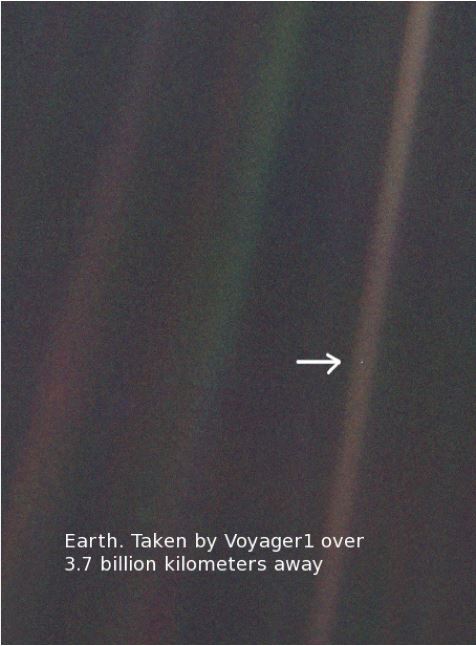
But in other ways it’s silly to think that fighting over our borders and resources down here is the way to go, when one asteroid could provide enough metals for an entire planet if we could figure out how to get it here and extract it. Energy wouldn’t be a problem if we could harness solar energy outside of our atmosphere and get it down to us cleanly. Even things like gravity prevent some manufacturing and biological development from continuing, so what if we could create laboratories outside of Earth’s gigantic gravity well?
What if?
These are huge questions with no easy answers, and I don’t claim to have any of them. I’m just a nerd who likes to philosophize. Get a couple drinks in me some day…
But for now, I’m going to play one of the grandest games I own: Stellar Horizons, by Compass Games. This lil’ ole game starts in the year 2030, and plays out year by year until you’re rubbing elbows with Alpha Centauri and terraforming Mars while astronauts are jumping up and down on Triton for funsies in 2169. It’s a slow ride (play time is 8 hours or so), but a fun one. It’s a Space Agency simulator that plays from 1-7 players. There are shorter scenarios in the box, like a short race to colonize mars, or to save Earth from a meteor strike, but the full game is where it’s at. So that’s what I’m doing.
There’s a whole lot going on in the game, but the good thing about it is that it starts relatively small (kinda), and grows as the game goes, so it’s not crazy complicated right off the bat.
I mean, as far as the games I play go….
So buckle in as we transport ourselves seven years into the future….

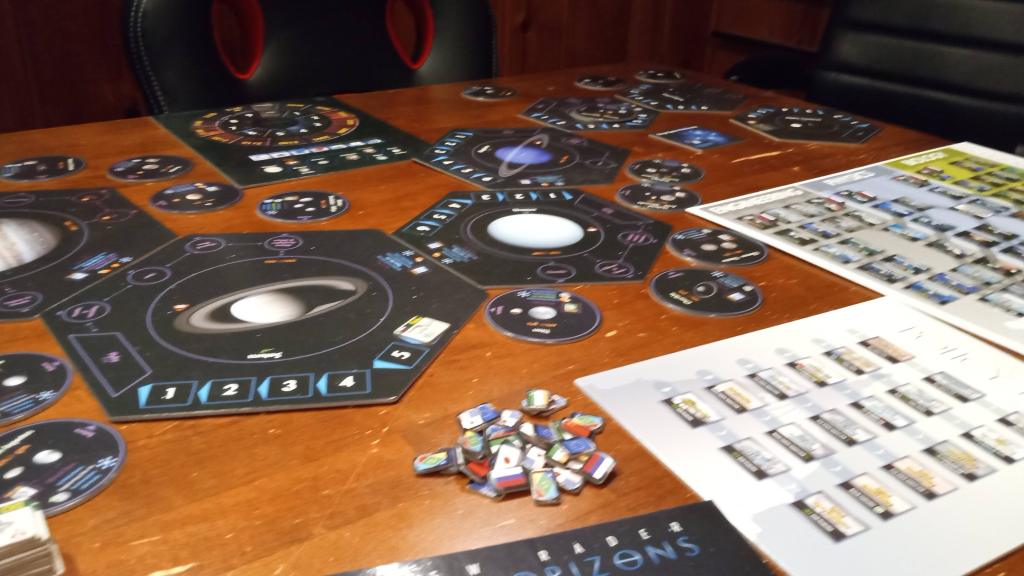
Space is laid out in front of us, and much like how space looked from the Hubble in the early 90s, it appears to be awfully fuzzy. Sorry about that. I’ll try to get better pictures in the future (heh). You’ll notice the game is BIG. There are probably more efficient ways to place the planet and moon tiles to get them to fit on a table better, especially if you don’t lay them all out in a line like this, but I like them to at least be slightly in an order relative to the sun.

I shall be playing as Russia. Due to the death of their former leader in 2024 (ahem), Russia has been on a bit of a kick to rebrand itself and improve its place in the global economy. It has decided to do that by greatly increasing its space program, putting it back on par with the American, European and Chinese agencies. Russia starts with some technologies already in the can, as well as having fairly robust human crews, gaining a 5% bonus to all rolls to see if the humans can stay out another year. The governments have decided that getting science on Europa and Triton is a priority this Decade, which is good because I have an Orbiter already en route to Jupiter, but Triton is going to be a hike, so we’ll have to figure out how to get something out to Neptune for that.
We also have a small shuttle able to get humans out to the Moon and Near Earth Asteroids right off the bat. Not sure what I’ll do with them, if anything, as human exploration is often fruitful, but expensive. Perhaps I’ll start with robotic exploration and if I find something nice, then I’ll send the humans out to milk it dry. I dunno. Stellar Horizons is a GIANT sandbox, which is what makes it fun. So let’s play, shall we?
We start with 30 billion dollars.
I’ll just let that sink in.
Ah.
Wouldn’t that be nice?
Anyway. We can spend that on building our ships here on Earth. We can also use this phase to build ships on bases out in Space, but I don’t HAVE any bases yet, so we’re just going to focus on Earth for now. I think my long range plan is going to be chucking a whole lot of robots into space so that they rust over and die by the end of the decade, so I don’t have to pay upkeep costs in 2040. You see, you have a limit to how many things you can have out at once that you check at the beginning of each Decade, for Russia, it’s 1 Robot, 2 Shuttles and 2 Bases. Due to the Political Policy Russia starts with, you can actually have 3 manned spacecraft flying, but as you’ll find out as you’re reading this, there’s modifiers a-plenty for EVERYTHING.
So I’ll spend my money on a bunch of Robots. Orbiters, Space Telescopes, Rovers, you name it. Also a bunch of launch vehicles. I don’t have the tech for reuseable launch vehicles, so it’s going to cost me at least 2 billion each time I put something into space. Oof.
So in 2030, Russia has launched an Orbiter to Neptune, and a Space Telescope into Earth Orbit. Each of these had a 5% of failure during liftoff. You roll percental dice, so it’s a straight 5 out of 100 roll to see if each thing just explodes and doesn’t happen. It stinks, but that’s the simulation aspect of this game kicking in here.
At the beginning of the game, Russia also has an Orbiter spinning around Mars, as well as one already en route to Jupiter. There is also a flyby satellite on its way to Saturn. Those take time to get there (space is big, if you recall), but I can work on getting science with the Mars Orbiter right away, along with my new Space Telescope.
You get Science by adding up the Science number on the robot you’re using + the number on the heavenly body you’re exploring. For every multiple of 10, you draw a chit out of the type that body represents (either Physics, Engineering or Biology). For Mars, it’s a 6 Biology. Add that to the 2 on the Orbiter and I’ve got 8. Not enough to draw a chit, but for any fractions you roll a d10. If it’s that number or less, you get to draw a chit as well.
BUT, you also have to roll to see if the robot breaks down. For that you have a 30% of happening. So in truth, you roll 3d10 each time, 2 for the percentile chance of something breaking, and 1 for the chance of finding science (you can forgo 1d10 on the odd time that you have an exact multiple of 10 for finding science).
So for my Orbiter, I peer down at Mars and…roll a 10, so I find no Science, AND I roll a 17, which means the Orbiter immediately goes dark. Wonderful way to start the game. However, you still learn something when your stuff breaks. I get to draw an Engineering chit because you learn stuff when your stuff breaks.
Now your Space Telescope has to stay in Earth Orbit, but can be used on any location on the board, however, that site only counts HALF of it’s science number. Usually you use it on the Deep Space Astronomy space, because only Telescopes can use that spot, and it has a “9” to start with, so half of that is 4.5, and .5 is rounded up, so 5+1 is a 6 or less to get Science. Not bad.
Of course I roll 7. *sigh* At least the telescope didn’t break.
So not much happened that first turn. Some things were launched and flew through space and some things broke. Science is slow. I’ll try something else next turn and see what happens.
2031: While I wait for things to fly through space, I buy an Orbiter and fly it to the Moon. That only takes one turn (year) and that way I can get some immediate returns.
Or I roll high again and don’t get jack squat.
2032: I launch a new flyby satellite to go past Jupiter and eventually past Neptune to help satisfy the two missions, just in case my luck continues on this path. I get some science from the Rover. FINALLY get my first Depletion.
What’s that, you ask? Whenever you pull a chit that is a 3 or better (There are 3’s and 5’s in each pile o’ chits, but not many of them), or if you’re using humans and drawing more than 1 chit at a time, your total is 3 or better, you score what’s called a Depletion. It’s named that because the number on the object you’re studying is Depleted by 1, making it harder to get more science out of it. However, you also gain a Politics marker because people like it when you make discoveries. You also get to draw a World Card, which is a special token that if it matches the world you’re on, modifies it in some way. (Deep Space Astronomy doesn’t have a spot for a World Card, so you don’t bother drawing one, your telescopes aren’t THAT good).
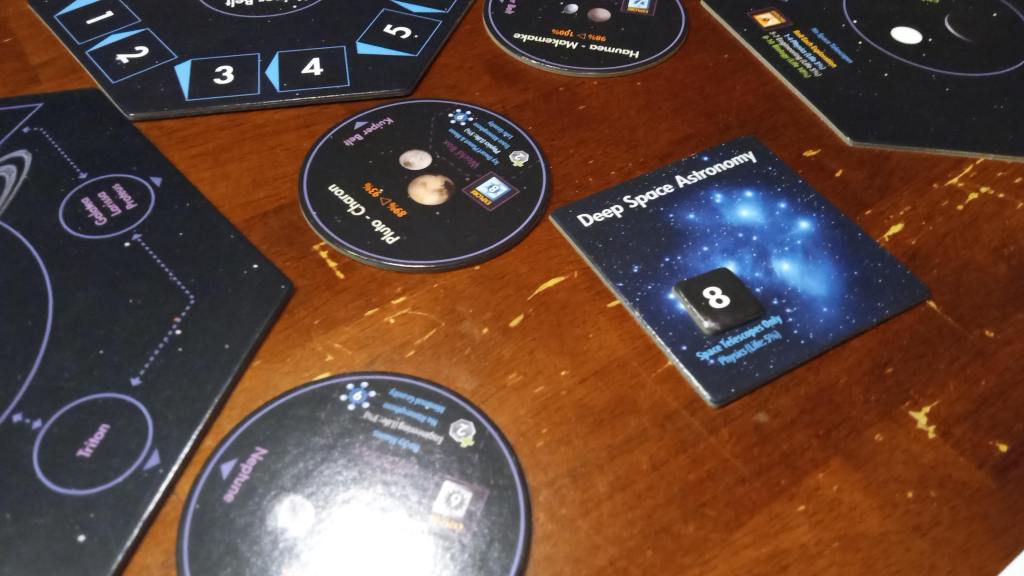
You also get to roll to see if you found a sign of life. Odds are usually really really small (though larger in areas like Mars and Europa, where we’re naturally hoping to find signs of ancient life). Here there’s a 5% chance of seeing life among the stars. I, of course, don’t roll in the 5% zone. So really, all I got out of that was a Political Marker. Don’t get me wrong, that’s a good thing, you can exchange those for money, or to improve your standing with other nations, which really helps you out in the long run.
2033:
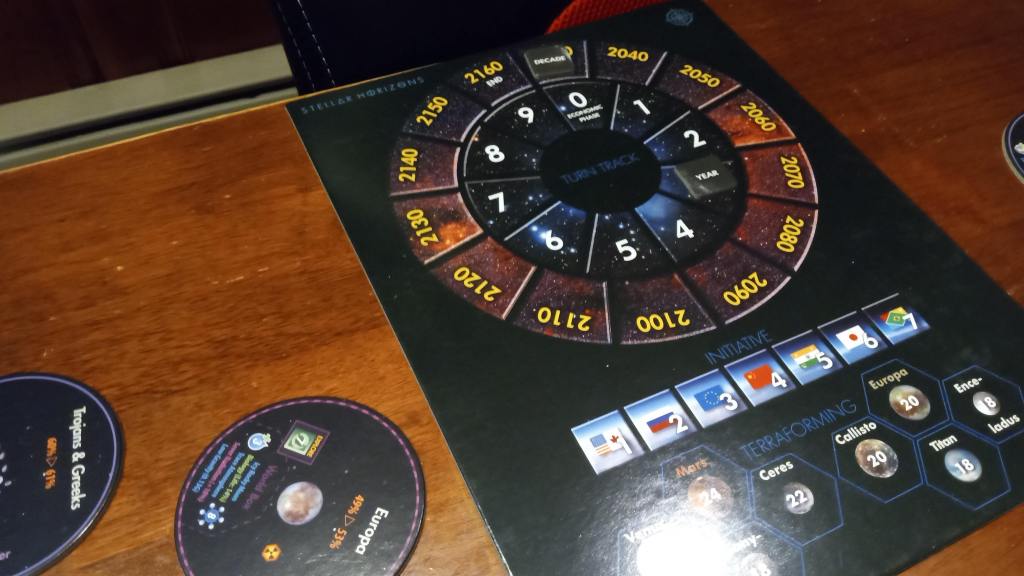
So my new Orbiter reaches Jupiter and…
immediately goes dark.
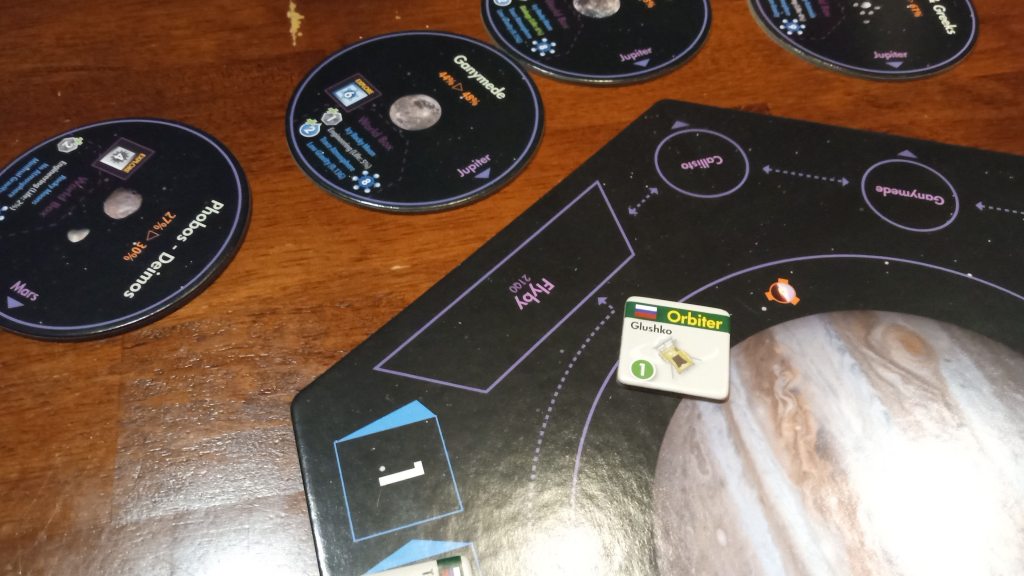
This effing guy.
2034: I think I’m going to prep for Human missions around Earth at this point, ’cause clearly Russians weren’t meant for Robotic exploration. But luckily this year, I’m able to get another Depletion on the Moon right as the Rover shuts down after spending quite a few years on Luna.
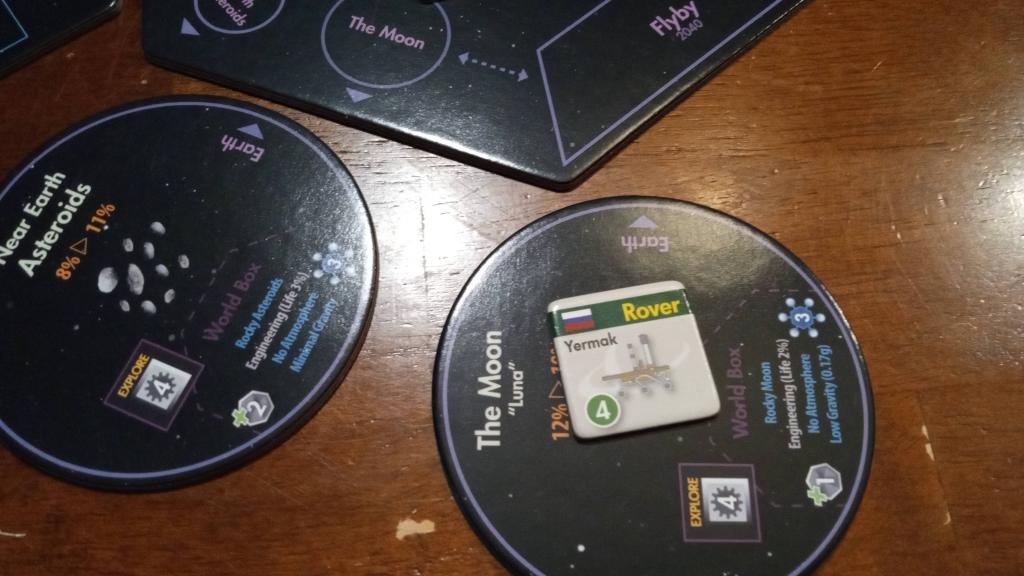
No signs of life, and the World Card I pulled for it was only meant for a Gas Giant, so no change there. Yermak, we hardly new ye.
2035: I send my first human Astronauts to a Near Earth Asteroid and they get some science there (an Engineering Chit), but don’t make their roll and have to flip to their “Reserved” side, meaning they can’t do any more science until they get more supplies, which they’ll have to get back on Earth. So a 1 year mission, then back to Earth for 1 year of refitting the ship, then back out again. 2 billion to refit the ship too, not counting the cost of the lift vehicle. Luckily you get a free Biology chit when you fail the Recall roll. Also this year two of my flyby satellites, um, fly by and get pictures of Mimas and Europa, but fail to make Depletions and continue on to their next planets.
2036: Apparently according to my notes I had sent an Orbiter to the main asteroid belt at some point, because it stopped working this year? I don’t remember doing this as it was several days ago. Sorry ’bout that folks.
2037: Flyby pictures of Saturn and Uranus come back, both giving some fine science. I must have been low on money as my notes are sparse by this time.
2038: Success! The Glusko II Orbiter gets a Depletion and my first Mission is complete.
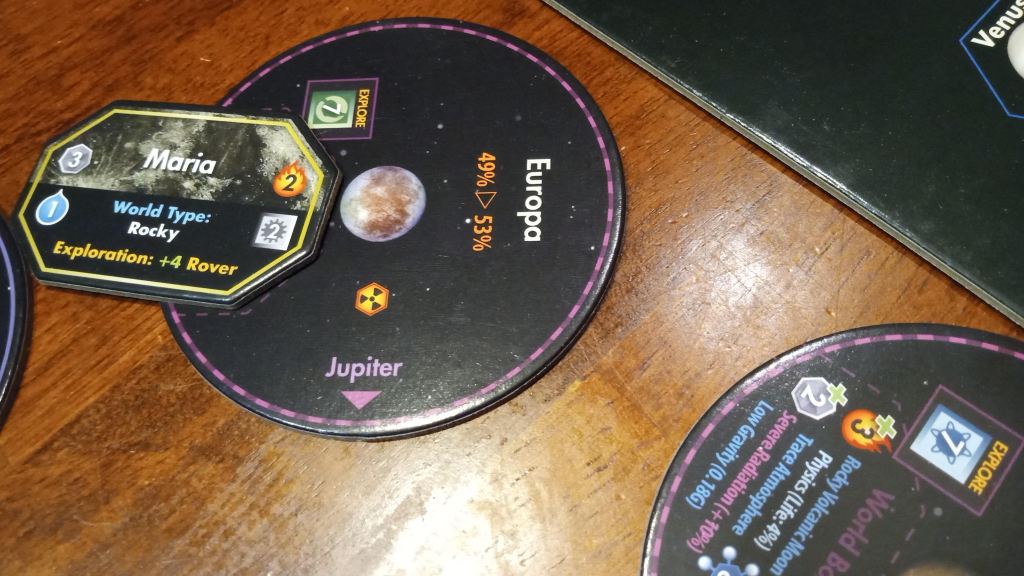
Not only that, but I have a successful World Card pull, which means if I were to build a base there, it could produce any of those resources (modified by whatever’s under the card). Also makes me want to get a Rover down there as it’s an 11 even before I add the 4 I get from the Rover, so I already get a Biology chit automatically, and a second on a 5 or less? I like that.
The Mission chits get you an extra billion at the beginning of every decade as well as victory points at the end of the game. You can only have one earned per decade, so if I score another one, it’ll get discarded and just taken as a Victory Point marker, but that’s still something, so I’ll still go for it. I draw a new Mission and get Ganymede, so naturally my Orbiter just has to turn its cameras to another Jupiter moon. No problem.
2039: I get some pictures from Triton for the first time, but nothing to write home about.
2040: We begin the new decade! So some new stuff happens! First, we get 2 free Diplomacy tokens. Hooray! We can spend those for a billion each. We can spend those for 2 Research, which is nice. We can spend them to try and influence our Non-Player Factions to like us better (good for trading, once bases are out on the board) and we can also trade them (at a 4:1 ration) for sweet, sweet victory points. We also roll on an event chart that can do all sorts of things, like give more money, influence politics, or hurl planet destroying asteroids directly at Earth.
Even aliens!
Ya heard me. Even in this hard sci-fi game, there is a small percentage chance for the arrival of aliens. There is an ‘*’ beside the “game changing” entries like that to say “only do these if everyone at the table agrees.” Because if you came here to slowly explore the Solar System and all of a sudden you’re PEW-PEWing the night away…yeah, I can see where some folks would be miffed.
Anyway, the event I roll would set a bunch of politics back toward Neutral. Considering they’re all already at neutral, it does nothing. Big deal.
So we do diplomacy. I’ll spend my chits to try and move all those Neutral folks out and into “Friendly.” The reasoning for this is each Friendly state gives me an extra 1 billion at the beginning of the Production phase of the decade. You get it at the roll of a 6 or less on a d10.
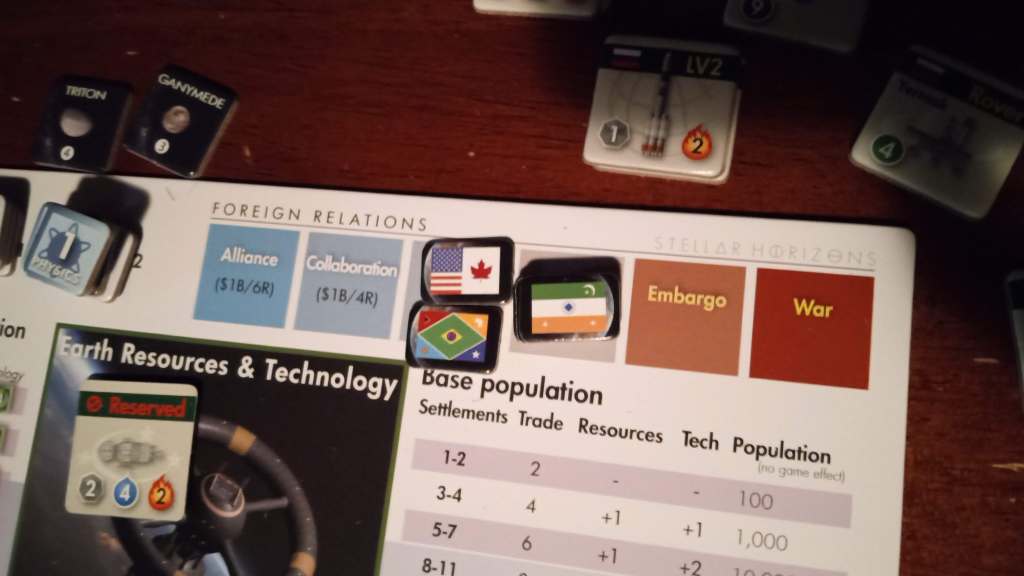
Looks like people are still bitter over Ukraine. Only two move up, but it’s beter than nothing.
Then I get production. Earth produces 28 billion dollars and a few research points itself, then I pay upkeep costs over my limits and…
Uh oh. I have a LOT of Robots in flight. Remember how I said I was going to have those robots die off so I didn’t have to pay upkeep? Um. I kinda slacked on that. I am now over my limit by 4, which is the maximum I’m allowed to be over. For having one robot too many, you have to pay 2 billion. For two too many, you pay 3 billion for the second….and 2 billion for the first. For three, you pay 4 billion for the third, and 3 billion for the second and 2 billion for the first. You can, however, choose to shut down a robot at any time to avoid this cost. I will choose to shut down a satellite that was moving past Neptune. While getting more science from the Kupier belt would be neato, I’m saving 5 billion dollars this way. However, I do want to keep everything else out there, so I start the decade already shelling out 9 billion. Ooops.
I then roll to check and see if any Non-player Factions have built a base. I roll percentiles and every body in space has numbers relating to the 1-100 chance. Each body also has a year that it will be built under. This early I think we can only get bases built around the Earth, Moon and Near Earth Asteroids. I don’t roll anywhere near there, so no bases are placed. Later on in the game, we add rolls to add minable asteroids as well as rogue Pirates. Neat, right?
Now I can cash in my chips and buy new technology.
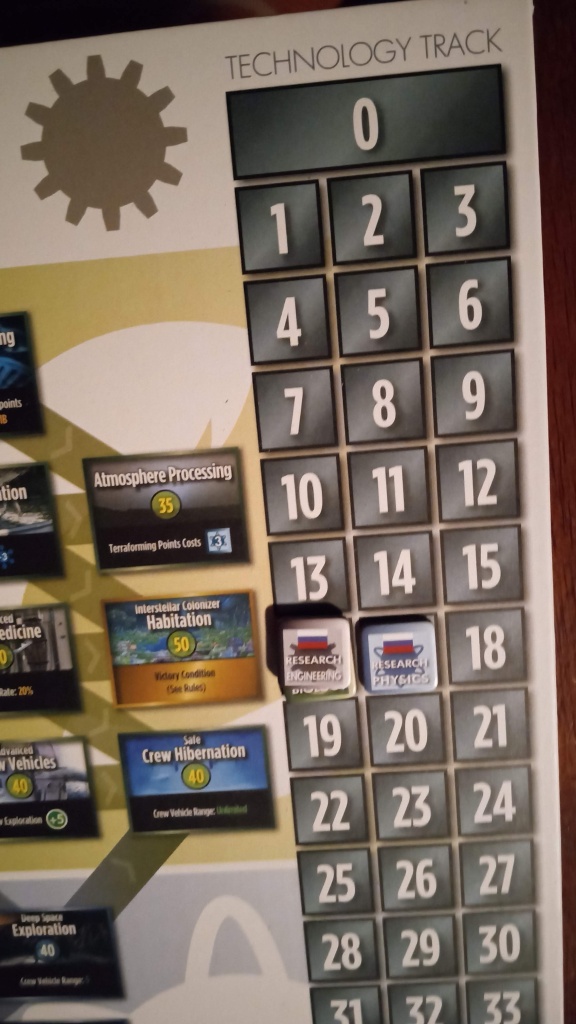
I was pretty consistent, with Biology and Engineering both at 16 and Physics at 17. Since early tech is 10, 15 or 20 points, it makes it pretty easy to choose. For Biology I got Space Habitation, lowering my Recall roll failure rate by 5%. Physics I took Advanced Astrodynamics so I’m able to fly to Mars! And Engineering I took Improved Component Design to lower that failure rate by 3%.
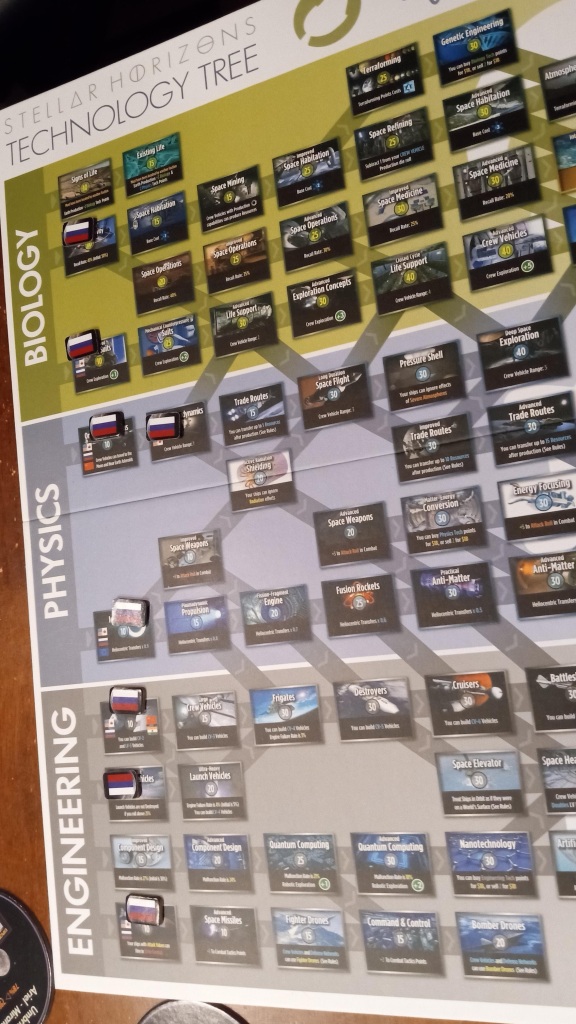
Sadly after spending all your tech, your remaining points are halved, so saving up for big tech jumps are a no-no. You gotta spend them when you get ’em.
Then you get the “Policy Step” which is a small tree of bonuses you can take for no cost depending on your strategy. Russia starts with a “human” strategy giving you +1 to the number of humans you can have in flight. I choose to add a flag (I couldn’t quickly find a Russian flag so I just chuck another one down as a place holder for the picture) to give me a +1 to the number of robots I can have in flight so I don’t get into the same mess I got in this turn.
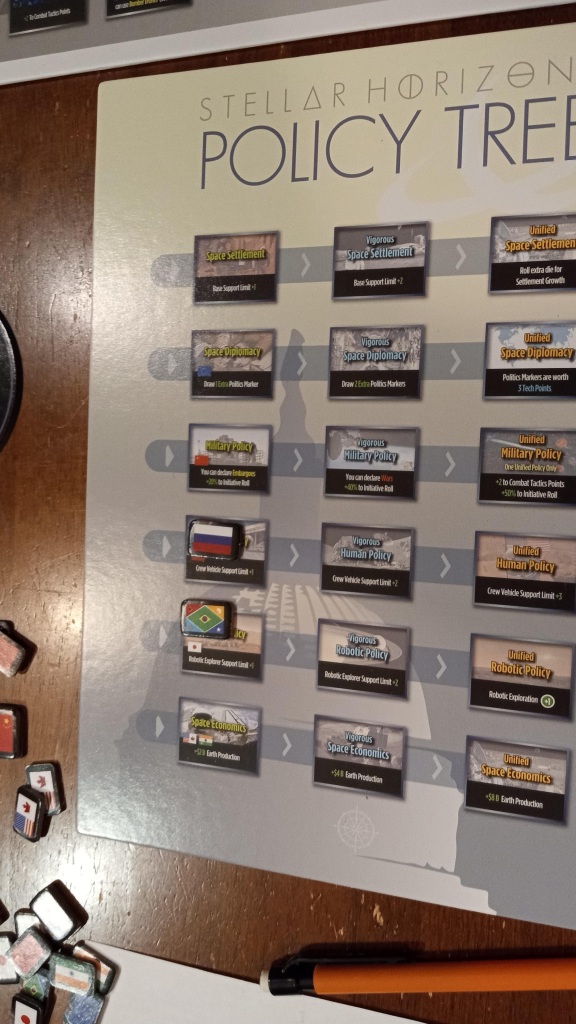
And that’s it, then we go back into Production, then movement, then science….it picks up as Bases get built, planets get terraformed, Pirates get in the way. You’ll see.
But wait, WHY are we doing this? Victory Points, of course! You saw that I got 1 for completing a Mission when I was passed the limit for my decade, there’s also a Mission value based on their difficulty (Right now I have a 4 and a 3 showing, don’t know how much variability there is). You also get points for:
Reaching the end of the tech tree in the three branches (50 points for all 3, 30 for 2 or 15 for just one of them)
Having the most settlements on a Terraformed World (25 for a fully terraformed world, 10 if it’s half way there)
Exploring Alpha Centauri (15 with humans, 5 if just robots, 20 if both)
Building Settlements (point values based on distance from earth, 1 each in Earth Orbit, a little more the farther you get away, worth more on a terraformed world)
Having facilities on bases (“Infrastructure”)
You gain a half point for every size of ship you have in flight at endgame
You gain points for leftover tech points and politics markers at endgame
You LOSE three points for every tech not learned – this is a biggie which hosed me the first time I played.
When playing solo, you have a tiered system of victory:
Less than 100 is a Disaster (Think I ended with 61 points the fist time I played)
176 is the first Victory tier
251 is ridiculous.
I’m hoping for 151, which is draw. That’ll make me happy.
So that’s it. 10 Years of game. You play until 2145, then you have a 1% chance of the game ending. 2146, a 2% chance and so on. If the game hasn’t ended by 2169, it just ends because….just because. Right now I’ve earned about….9 points (not counting the tech points lost). I have 142 or so to go. I have 105 turns to get them, so it seems doable.
Right?
RIGHT?
(Does math, realizes he’s not even averaging a point per turn)
Dangit.
